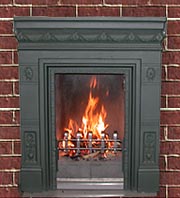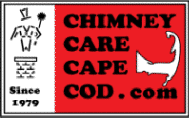Improving Chimney Safety, Performance & Efficiency Since 1979
Chimney Talk
Everything you ever wanted to know about chimneys but were afraid to ask!
Inspections: The first step in evaluating the condition any chimney is a thorough inspection. Note: The NFPA recommends annual inspection of all chimney flues on an annual basis. The most common type of inspection is a Level I inspection, and is typically performed when a evaluating a particular problem, when performing routine chimney maintenance, or when a house is being sold. This is a visual inspection which involves assessing the safety and structural condition of readily accessible areas of the chimney structure. Sometimes in the course of a level I inspection, it becomes necessary to perform a more detailed inspection procedure, such as a video inspection or a smoke test. A Level II inspection done in preparation for installing a woodstove or different heating system is slightly more involved, but the basic principles are the same. Occasionally, if an insurance company has become involved because of a fire or carbon monoxide related incident, an even more detailed Level III inspection may be required, which often involves gaining access to the chimney where it is hidden behind walls, floors or roofs.
Cleaning: Fireplace chimneys and chimneys used for venting wood stoves , pellet stoves, coal stoves and oil fired heating systems, need to be cleaned to remove combustion byproduct deposits. These deposits include combustible creosote in the case of wood/pellets, and corrosive draft defeating deposits in the case of oil and coal. Chimney Care of Cape Cod specializes in power (rotary) cleaning of chimney flues. This cleaning method is far superior to manual wire brush cleaning. The cleaning heads vary depending upon the deposit being removed and the flue size and include poly wire brushes poly whips, wire whips and chain link devices.
Repairs: The most common type of repairs needed on masonry chimneys are crown replacement/repair, brick replacement/repair, pointing, weatherproofing, flashing repair, cap replacement/installation, damper replacement, liner replacement/installation and smokechamber parging.
Liner Installation: A chimney is only as safe as the flue liner inside of it. The liner keeps dangerous flue gases contained within the chimney as they make their way up and out. Unfortunately many older homes don’t even have a flue liner. In newer chimneys that have clay tile liners, the liner may be damaged from a chimney fire, freeze/thaw cycles, or spalling due to the corrosive effects of acidic deposits. Sometimes the flue liners were never properly installed to begin with and are severely offset, discontinuous or unstable.
The different types of replacement liners available include, Stainless Steel flexible liners (heavy interlocked, smooth wall two ply and light weight single ply corrugated), Stainless Steel rigid liners, cast in place liners, hybrid stainless liners with wrapped or cast insulation and Aluminum liners. The most commonly installed liners are the light weight single-ply Stainless liners. These liners are easy to install, but the wall thickness is typically only 5 thousandths of an inch thick and not are not very durable. We do not install this type of liner except in very specific cases, such as when a liner needs to be ovalized. Inexpensive and lightweight Aluminum liners can theoretically be installed with some gas fired appliances We will only install small (3 inch) aluminum liners for gas hot water heaters and gas stoves/fireplaces, and even then only if the flue is straight and has never been used for burning oil or coal. For wood stoves, wood inserts and wood furnaces, we generally will only install heavy interlocked liner. These liners have a total wall thickness of nearly 1/8 an inch and are the only flexible liners that can withstand a chimney fire. The lighter weight liners are not designed to withstand chimney fires and the liner warranty will be null and void.
Chimney Caps: Chimney Caps come in many designs, shapes, and materials. Most are designed to keep precipitation, animals and leaves out of the flue, as well as acting as a spark arrestor. Water running down the flue can cause problems with tile liners, smoke chambers, smoke shelves, dampers and fireboxes.
Caps can be make of painted galvanized sheet metal, Stainless Steel and Copper. We do not sell the galvanized type as they tend to rust out, becoming unsightly and eventually coming off in the wind. Copper Caps look terrific, especially when the house also has copper gutters ot flashing. Stainless Steel caps are less expensive than copper, and generally a little stronger (copper is a softer metal) The stainless caps can also be painted black, bronze or dark brown.
For chimneys that have more that one flue, it makes more sense to cap the chimney with a multi-flue cap than with individual flue caps. The multi flue caps do a better job of protecting the flues and the crown of the chimney, as well as looking much nicer. Caps can be crown mounted or perimeter mounted. Either way, the base of the cap (which is attached to the screening) is permanently mounted to the chimney top and the lid of the cap is removable for servicing.
Dampers: When dampers become compromised due to rusting , warping or breakage, they can be replaced. The best way to deal with a problem damper is to replace it with a top sealing damper. There are many advantages. This style damper does a better job of keeping warm air in the house and keeping water out of the chimney. Top sealing dampers also make fires easier to start since the flue is not filled with heavy , cold air upon startup - no more waving a lit piece of newspaper up the chimney!
Weatherproofing: There are four primary sources of water in chimneys.. The first source is water entering the flue (see section on caps) The second is water entering through the crown of the chimney. The crown is the layer of mortar or concrete that covers the top course of brick. A cracked or broken crown will allow water to enter the top of the chimney and can damaging the integrity of the top courses of brick as well as the flue liner. The third source of water is the brick itself. Some are nearly waterproof, but most bricks are porous to varying degrees. The solution is to apply a vapor permeable waterproofing product to the brick exterior. The sealant is applied using a low pressure sprayer, like a deck sealant sprayer. Enough must be applied to permeate the brick adequately or the brick will still be porous. Coverage rates vary from 50 square feet/gallon to 150 square feet per gallon, depending upon the porosity of the brick. Typical masonry products (those available at hardware stroes and Home Depot need to be reapplied every year. This is fine for your front steps, but not for your chimney. The best products are vapor permeable (not waterproof) silicone based sealants that only need to be reapplied every 10 years. The last common source of water related to chimneys is the flashing. The flashing where the chimney meets the roof is a bigger problem the flashing where the chimney meets the sidewall, but both can have problems. The solution to a flashing problem can be as simple as applying some silicone or polyurethane sealant to the gaps, or completely encasing it with a three part sealant/substrate/sealant flashing system.
Wood stove Installations: Improperly installed wood stoves are the single most common source of chimney fires in residential homes. The only way to safely install a wood stove into a fireplace is with a liner system that extends from the outlet of the stove to the top of the chimney. This will help keep the flue gases warm enough on their way up and out the chimney, and help to avoid sever creosote problems. A few years ago, the codes were changed to reflect the problems associated with partial installations into fireplaces, i.e. an installation where the pipe connected to the stove outlet only goes up through the damper frame and into the smokechamber.. The latest version of NFPA 211, states that if the cross sectional area of the flue exceeds 2x the cross sectional area of the stoves flue outlet when the chimney is on an outside wall, or 3x the area when the chimney is centrally located, the liner must extend to the top of the chimney. This means that the most common size fireplace flues - 12x12 and 8x12, must be completely lined. In a central chimney, you aren’t required to completely line an 8x12 flue (although it is still a good idea) but must do so with at 12x12 flue.
The other compelling reasons to completely reline a fireplace stove installation are that stove performance will be significantly improved due to increased draft stability, and the installation can be cleaned in place without having to disconnect the stove or remove the pipe going up into the smokechamber. This makes the cleaning less expensive, not to mention that it is more likely the cleaning will get done properly and the stove to be reinstalled properly.
CSI Certified - Insured Guaranteed
FAST CONTACT:
P.O. Box 202
Marstons Mills MA 02648
508-420-9261
Email

